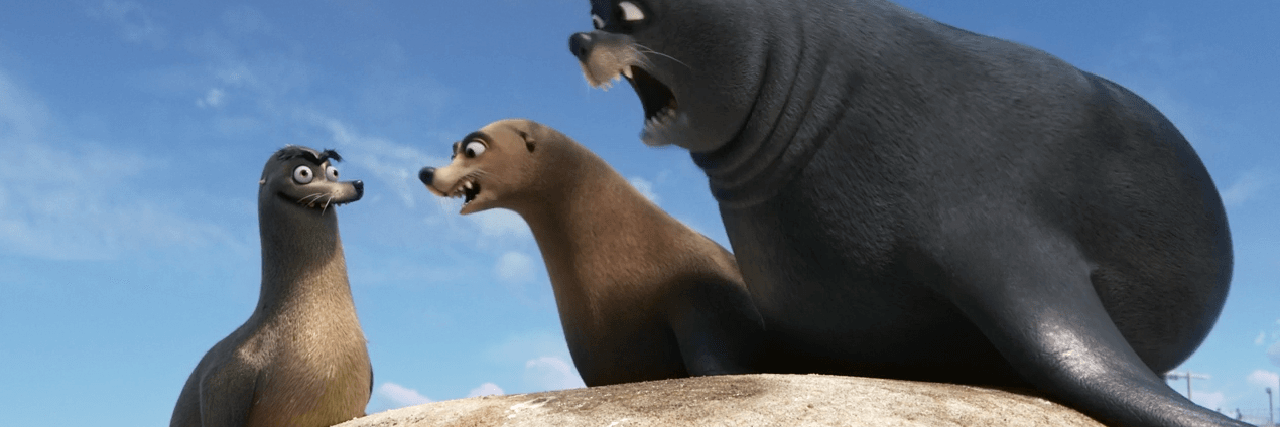In general, I loved the movie “Finding Dory.” In fact, I thought it mostly delivered a great message about disability inclusion. A big part of the story centers on how, despite her cognitive disability, Dory is able to successfully manage the world and find love and acceptance. Unfortunately, this beautiful message of inclusion and empowerment gets muddied while it stands in stark contrast to the included “Gerald” plot line, which is mean-spirited, heartbreaking, and completely tactless.
In case you missed Finding Dory or blocked the sea lion scenes out of your memory as I wish I could, Gerald is a sea lion who appears pretty clearly to have some sort of developmental disability. His goal in life is to join Fluke and Rudder, two seemingly neurotypical seals, on the warm sunny rock they bask on throughout the day. With his wide-set eyes, prominent overbite, exaggerated brow, friendly-but-naive disposition, and non-verbal role in an otherwise very talkative ocean, it seems to me that this character was intended to represent someone with a developmental disability.
 There are various scenes in the movie that include this trio, all of them with the “punchline” being that Fluke and Rudder harshly yell at Gerald to get off of their rock until he sadly sinks into the sea. At one point, Gerald has finally found a spot of joy; he’s got a bucket that he’s happily playing with. Fluke and Rudder call him over and offer him a trade — if he lets them have his new bucket, he can join them up on the rock. Eager to finally be included, he happily hands over his bucket to his “friends” who now seem to accept him. Fluke and Rudder allow Gerald a microsecond on the rock, then laugh and pull their trademark “Off off off off!” move, again shoving him sadly into the sea. His expression as he falls is the saddest thing I’ve seen in a Pixar movie — and I watched Toy Story 3.
There are various scenes in the movie that include this trio, all of them with the “punchline” being that Fluke and Rudder harshly yell at Gerald to get off of their rock until he sadly sinks into the sea. At one point, Gerald has finally found a spot of joy; he’s got a bucket that he’s happily playing with. Fluke and Rudder call him over and offer him a trade — if he lets them have his new bucket, he can join them up on the rock. Eager to finally be included, he happily hands over his bucket to his “friends” who now seem to accept him. Fluke and Rudder allow Gerald a microsecond on the rock, then laugh and pull their trademark “Off off off off!” move, again shoving him sadly into the sea. His expression as he falls is the saddest thing I’ve seen in a Pixar movie — and I watched Toy Story 3.
The most depressing part of this plot line is that Gerald never really gets his day. Fluke and Rudder never accept him or change their behavior toward him, but are still generally represented as “good guys” in the movie. There’s no lesson learned, no apology, no moment of realization. The story doesn’t address the way they bully Gerald and exploit his disability as a bad thing. It’s just a bitter punchline they hammer home over and over again. Gerald naively hopes for inclusion, and Fluke and Rudder repeatedly crush that dream by being cruel to him. That’s the whole joke.
Call me a party-pooper, but I’m not laughing. There are a few things this joke relies on for its humor. The first is that Gerald is “funny-looking” and different. If they had animated Gerald as super cute with big oversized eyes and chubby cheeks à la baby Dory, no one would have laughed at the bullies picking on him. Everyone would have said, “What was with that? That was horrible!” But hey, picking on people who are different is hilarious, right? The second thing the joke relies on is how funny it is when Fluke and Rudder team up to loudly shoo him away. It’s a familiar motif — a spin-off of the famous “Mine! Mine! Mine!” from “Finding Nemo,” which was irresistibly catchy. Sadly, so is this — and it builds a perfect stencil for kids to use when teaming up to exclude kids from the jungle gym at the playground.
With this film having disability empowerment as a major theme, why on Earth would the editors include this plot line? Who approved these storyboards? It’s a moot point now, really. At this point, the damage is done. The film is out there. The most we can hope for is that parents pick up where Disney left off to use the scene as a teachable moment.
If you took your kids to see “Finding Dory,” talk to them. Ask them how they felt about Fluke and Rudder. Ask them how they thought Gerald felt. Ask them what Fluke and Rudder should have done instead. Disney and Pixar made a big misstep here, but let’s turn it into something positive by talking to our kids about bullying — especially when someone is a little bit different from us.

